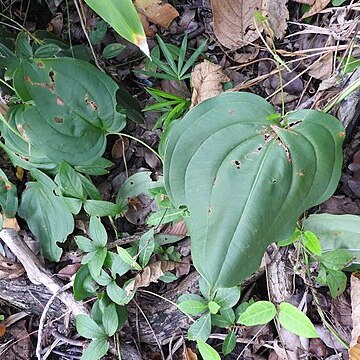Tubers cylindric, developed from short, thick rhizome; cork deciduous; transverse section white, drying light yellow. Stem twining to right, glabrous, prickly at base. Leaves alternate basally on stem, opposite distally on stem, simple; leaf blade drying blackish, usually ovate or long elliptic-ovate to lanceolate, 5--17(--24) × 0.5--10(--13) cm, glabrous, basal veins 5--9, base cordate to truncate or rounded, rarely sagittate or hastate, apex acuminate or caudate. Male spikes solitary or 2--4 together, 1--2.5 cm, usually in narrow, axillary panicles to 14 cm; rachis straight. Male flowers: outer perianth lobes orbicular, ca. 1 mm, inner ones obovate, smaller but thicker than outer; stamens 6, inflexed. Female spikes solitary or paired, to 25 cm. Capsule not reflexed, oblate, 1.5--2.5 cm; wings 1.2--2.2 cm wide. Seeds inserted near middle of capsule, winged all round. Fl. Sep--Dec, fr. Dec--Jan.
A yam. It keeps growing from year to year by sprouting from the tubers. The stem has thorns near the base. It twines to the right. The vine can be 8 m long. The tubers usually occur singly and are deep in the soil on a long stalk. They are 50 cm long by 4 cm wide. They have white flesh. The leaves are simple and can be opposite or alternate. The leaf stalk is 4-5 cm long. The leaf blade is a long heart shape. It can be 14 cm long by 16 cm wide with rounded ear shaped bases. The male flowers occur as 1-4 together and on branches 70 cm long. Female flower stalks occur singly or in pairs. They can be 40 cm long and with 50 flowers. (It is similar to Dioscorea nummularia).

